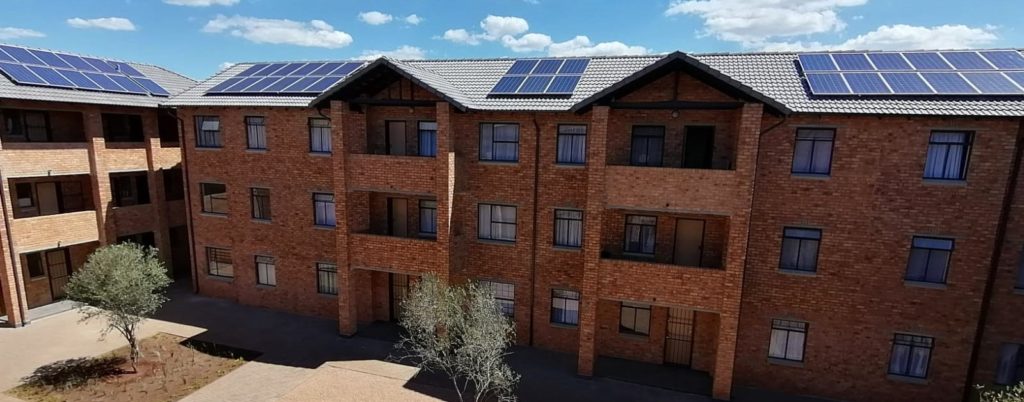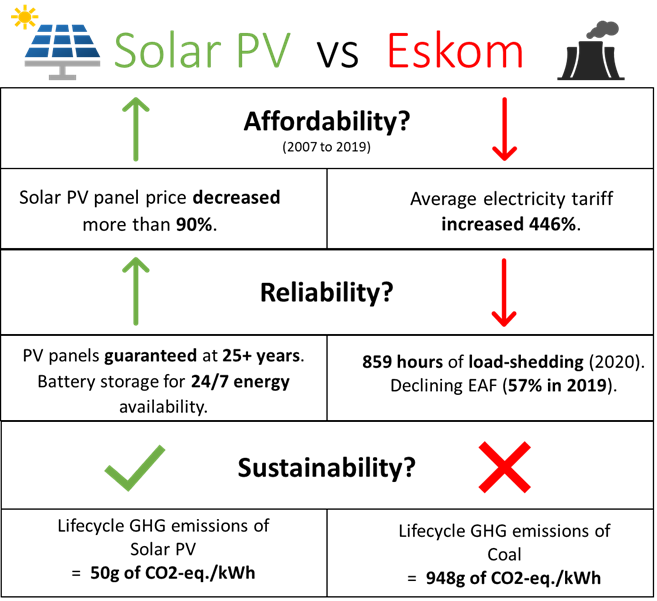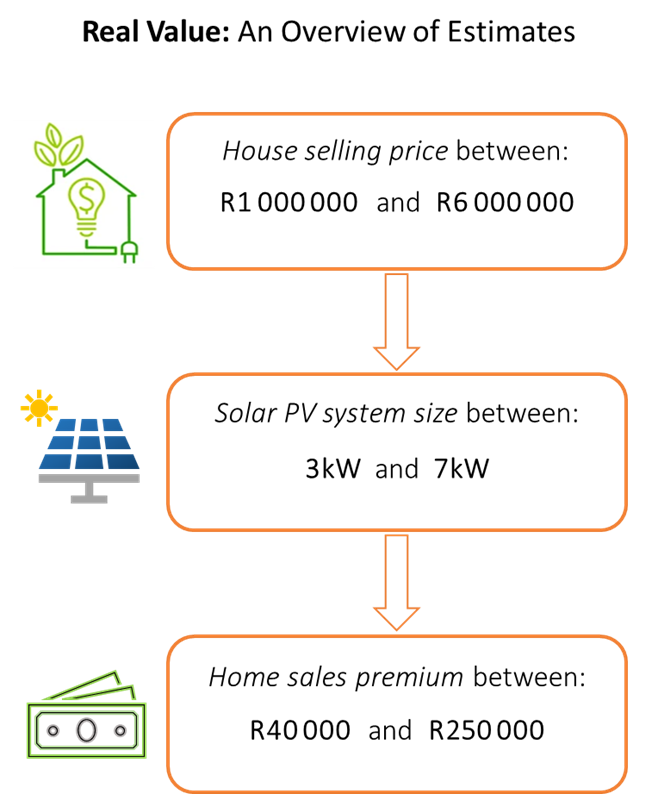
About this Article
To provide context we elaborate on why the reliability, affordability and sustainability of solar PV make it a viable and valuable addition to your home. Trends in the South African residential property market and challenges caused by Eskom’s unreliable and expensive ‘service’ are also discussed.
We then move onto the focal points of this article: Saleability and sales premium.
To get insight into how solar PV systems can improve the saleability of South African homes, we spoke to two local residential property experts: Sandra Gordon, Senior Research Analyst at Pam Golding Properties, and Anthony Stroebel, Head of Business Development at Pam Golding Properties and a Director of the GBCSA.
We conclude with a method designed to help you calculate a rough estimate of the potential home sales premium unlocked by installing a solar PV system in your home.
Read time: 4 minutes
Authors: Matthew Capes, Sean Moolman
The transition to clean energy is critical to securing a sustainable future for humanity.
In an ideal world this would be at the top of everyone’s to-do list, but each day brings its own challenges.
Especially in sunny South Africa.

For example: How do I manage to keep up with rising electricity bills? How do I cook dinner, have a hot shower, or watch some TV with my family, when persistent load-shedding and unexpected blackouts leave us in the dark?
Solar PV has become an increasingly affordable, reliable, and sustainable solution to the current challenges faced by many South African’s.
But what about the future?
An important reality often overlooked, is that the solar PV system becomes part of your home once it is installed; solar PV panels are routinely guaranteed at 25 years or more.
![]()
*At the end of this article, we provide a guideline to estimating your own home sales premium.
International research suggests that it can; a recent survey by EcoWatch in the U.S.A found that1:
Now lets discuss some insights closer to home. A lekker local perspective if you will.
We spoke with Sandra Gordon (Senior Research Analyst at Pam Golding Properties) and Anthony Stroebel (Director at GBCSA, Head of Business Development at Pam Golding Properties) about two forms of value:
Saleability, is the extent to which the home can be easily sold or rented.
Sales premium, is the ability to command a higher sale or rental price.
Gordon and Stroebel note, “Saleability is always relative to that particular moment in time i.e what else is on the market that would be competing for the same buyers…
Certainly, at this point in time, when solar PV has not necessarily reached any degree of critical mass, it is likely that solar homes will be competing with non- solar homes and will definitely therefore have a ‘value edge’.”
Let us elaborate on what that “value edge” is.

Stroebel and Gordon anticipate that “Despite the lack of local research on the matter, the fact that South African electricity tariffs are rising steadily and loadshedding is set to continue for the foreseeable future, it is extremely likely that any measures which reduce utility costs and increase a home’s independence from state utilities would increase its saleability”.
They explain: “With a large, young population – and with utilities becoming more erratic and expensive – new mixed-use developments typically include energy and water efficiency features, solar power and – in some cases – rain harvesting etc.
“These features are undoubtedly attractive to the majority of potential homebuyers and, based on international trends, will be particularly important to younger buyers (who are an important source of housing demand in South Africa)”.
Securing the value of your home means you should consider who the buyers are likely to be and what would attract them to your home.
Research conducted by COGNITION Smart Data found that Millennial home buyers have
“a strong ethic of sustainability” and are looking for “smart homes that are sustainable, efficient and healthy”.
Adds Stroebel, “Millennials want homes with the latest and greatest – and most environmentally compatible – technology.
“According to this research, millennials have a high level of interest in solar technologies to reduce their carbon footprint, reduce their energy bills and increase self-sufficiency. Trends which rising local tariffs and increased instability in delivery are likely to reinforce.”
So, they are young and they want to save the planet… and money too.
According to research conducted by CoreLogic, “Surveys have demonstrated that millennials tend to be more environmentally conscious. It is no surprise that they are the ones driving the green revolution in housing.
Solar panels will continue to be more popular on single family homes, each unit with its own battery and power management system”.2
Green features such as a solar PV system also provide financial sustainability in the form of direct savings on energy costs, improving the saleability of your home and a potential home sales premium.
In a 2018 survey by the Pam Golding Property group: “70.3% of its agents estimated that homes with green features record a price premium of up to 5%, while 54.4% of agents stated that buyers are showing increased interest in green features”. 3
According to Ooba, “energy-efficiency has become a buzzword for house hunters – not just because of load shedding, with homeowners around the globe trying to go green. A home that is less dependent on the grid makes for a sound investment opportunity”. 4

A smarter and more sustainable home can offer you cost savings and certainty through independence from Eskom. These solutions will undoubtedly make your home more attractive to prospective buyers.
All these factors (and more) combine to create a perception of value of in prospective home buyers’ minds.
As they say in marketing, perception is reality…
So does this perception of enhanced value translate into real value?
Listed in Table 1 (below) are several estimates from reputable international research for quantifying the potential home sales premium as a result of having a solar PV system installed.
Table 1: Sources of international research on solar PV and home sales premium
The Appraisal Journal cited researchers Ruth Johnson and David Kaserman | “value increase of about $20 for every $1 saved on annual energy costs” |
A study by the Lawrence Berkeley National Laboratory | “$5,000 resale value increase for every kilowatt (kW) of solar installed.” |
The National Bureau of Economic Research (NBER) | “price premium of up to 4% (depending on size and age/condition of system)” |
Reference – 5
Using the methods in Table 1 we created a rough guideline on how to estimate your home’s potential sales premium by having a solar PV system installed. *Please see Annexure B*
The estimates from the National Bureau of Economic Research (4%) in Table 1 and the aforementioned Pam Golding Properties survey (5%) are close enough to provide a basis for estimating the potential home sales premium in South Africa.
In the following illustration, we depict a range of potential sales premiums made possible by installing a solar PV system in a South African home.

*A Please see Methods and Assumptions
Acknowledging the limitations of applying these methods and estimates is pertinent, especially considering the lack of local data.
With that being said, we want to leave you with a final thought.
Put yourself in the prospective buyer’s shoes. Imagine you have narrowed your choices down to two houses on the same street. The selling price is similar and so are the houses. The only major difference is that the owner of one house decided to install a solar PV system.
The houses don’t seem so similar any more… one of them is smarter, more sustainable and offers independence from ever increasing electricity tariffs and protection against load-shedding.
Which house would you be more interested in buying or be willing to pay a premium for?
*We would like to extend a special thank you to Sandra Gordon and Anthony Stroebel. We greatly appreciate your time and effort spent on providing us with invaluable insights.
ANNEXURE A
We know that solar PV can offer independence from Eskom’s unreliable service.
Although we were in lock down most of the year, South Africa still experienced its worst year ever of load-shedding in 2020.A total of 1798 GWh shed and 859 hours of outages.
To put that into perspective, there are 8760 hours in a year… We had load-shedding almost 10% of the time in 2020!
Eskom has not been off to a good start in 2021 either. According to data from Eskom se Push we had already seen 560 hours of load-shedding in the first half of 2021.6
Will the situation improve?
According to a technical report by the CSIR, Eskom’s coal fleet’s Energy Availability Factor (EAF) has declined from 94% in 2002 to 57% in 2019. Degrading infrastructure, scheduled maintenance and unexpected breakdowns exacerbate the rate at which the coal fleet’s EAF declines.
This means the situation is likely to get worse (at least, before it gets better).7
Solar PV has also become much more affordable, whereas Eskom is progressively more unaffordable. From 2007 to 2019, Eskom’s average electricity tariffs increased by 446%. Over that same time period, the price of solar PV modules decreased by more than 90% from R57,4/Wp to R5,32/Wp. 8
For the 2021/2022 year, the average monthly electricity bill is about R1 508 across all income groups in the four major metropolitan areas (Cape Town, Joburg, City of Tshwane and eThekwini).*B
Solar PV is dramatically more environmentally friendly too.
Several lifecycle greenhouse gas (GHG) emissions studies show that solar PV, at only 50g of CO2-eq./kWh, has a fraction of the lifecycle GHG emissions of coal (948g of CO2-eq./kWh). 9
Remember, most of the electricity generated by Eskom comes from coal fired power plants.
These studies analysed the emissions over the entire lifecycle of each technology. From mining of raw materials to manufacturing to operation to decommissioning at the end of its useful life.10
ANNEXURE B
*Monthly electricity and solar PV system cost estimates from Table 1 were adjusted to reflect those in South Africa.
Using the methods from Table 1, we begin our calculation with R2 034, the average monthly electricity bill for lower-middle to upper income groups (LSMs 5 to 10) for the 2021/2022 year.*B
According to the Appraisal Journal, a solar PV system can enable a home sales premium of up to R20 for every R1 saved on annual energy costs.
To calculate potential annual savings, we multiply the R2 034 average monthly electricity bill by 12 months, which equals about R24 000.
Next, we multiply R24 000 by R20 which gives us a potential sales premium of R480 000.
To get to that same R480 000 but using the Lawrence Berkeley National Laboratory method which estimates R75 000 sales premium for every kW of solar installed – you would need to have about a 7kW solar PV system installed. *C and D
According to a 2021 BusinessTech article, having a 5kW solar PV system installed will cost about R110 000.
This equates to R22 000 per kW installed, thus we can expect the 7kW system mentioned above to cost about R150 000.11
If our potential sales premium is about R480 000 and the cost of our solar PV system is about R150 000, we arrive at an arbitrage opportunity of R330 000.
We must consider that, if the potential 4% sales premium is R480 000, the total starting price of our home would need to be R12 000 000.
Since most of us don’t have a home valued at R12 million, let us work out the sales premium using the average selling price of houses in South Africa for property in the lower-middle (R638 200) income group to luxury value property (R2 300 000).12
In 2019, the average selling price of houses for the above groups was about R1 300 000. Subsequently, the 4% sales premium would be about R52 000.
REFERENCES
1 – https://www.ecowatch.com/solar-growth-outlook-survey.html
3 – https://blog.pamgolding.co.za/greener-living-rise/
4 – https://www.ooba.co.za/resources/living-off-the-grid/
5 – https://www.solarreviews.com/blog/do-solar-panels-increase-home-value
8 – https://ourworldindata.org/grapher/solar-pv-prices
9 – https://www.ipcc.ch/site/assets/uploads/2018/02/ipcc_wg3_ar5_chapter7.pdf
12 – https://www.intergate-immigration.com/blog/cost-of-living-in-south-africa-ultimate-guide/
Methods and Assumptions
*A – The ranges shown in the “Real Value: An Overview of Estimates” illustration, as well as the more detailed sales premium estimation guideline found in Annexure B, are based on rough international data which we further adjusted to make it more relevant in the South African context.
With many variables, some of which have changed drastically over the last few years, these sales premium ranges and estimation guidelines are rough at best. They are only intended to give a basic idea of how a solar PV system can potentially lead to a home sales premium.
*B – Average residential electricity consumption data was obtained from: Goliger, A. and Cassim, A. (14 and 15 July 2017). Tipping Points: The Impacts of Rising Electricity Tariffs on Households and Household Electricity Demand. 3rd Annual Competition and Economic Regulation (ACER) 2017 Conference, Dar es Salaam, Tanzania. Last accessed: 21/08/2017.
*B – Average effective residential electricity tariffs were calculated from the published 2021/22 tariffs of the following four metropolitan municipalities: City of Johannesburg, City of Tshwane, City of Cape Town and Ethekwini, using the average electricity consumption values for LSM5-10 obtained from the above references.
*C – The solar PV systems as discussed in this article include battery back-up. Thus they are either hybrid or off-grid residential solar PV systems. Grid tied systems do have some form of back-up (AC grid power) and provide cost savings with solar energy. However, they do not have back-up in the case of load-shedding. Thus, in our estimations we focused on hybrid and off-grid solar PV systems.
*D – At the time of writing the exchange rate was R15 to the Dollar
Questions? We’ll get back to you on how to join our journey!
I want updates from Elon Smart Water (you can unsubscribe at any time)
By clicking submit, you consent to PowerOptimal storing and processing personal information.
Please read our Privacy Policy.
PowerOptimal and Elon Smart Water are committed to protecting and respecting your privacy.